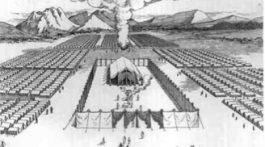Sabbath School Lesson for February 15-21, 2020
Overview
Several characters were seen in Daniel’s dream, which gave more detail to the dream Nebuchadnezzar previously shared in chapter two…
- description of four beasts/animals, which represented the same kingdoms as the king’s dream–verses 3-7 (Sunday)
- introduction of a little horn power that would emerge after the fourth beast or kingdom–verse 8 (Monday)
- awareness of a judgment going on in the heavenly courts above–verses 9-10 (Tuesday)
- unfolding of the manner of Christ’s Second Coming in clouds and the worship He receives upon arrival–verse 13 (Wednesday)
- identification of saints or holy ones who are delivered from persecution to exist forever in the kingdom of God–verse 14 (Thursday)
Introduction
The disturbing details that were unfolded to Daniel in this nightly vision were explained by an angel that appeared in his dream. Daniel was understandably troubled and shaken by the scenes, even after the interpretation was given.
Several things might be noted in Daniel’s prophetic dream of chapter seven…
- He has the vision at night, with the sea being agitated by four winds. This brings to mind the creation, the darkness and waters prevalent on our unformed planet in the beginning. But the windy, stormy conditions seem to indicate this creation being under some kind of attack.
- The four beasts are all considered unclean by God and hybrid, with combinations and unusual features described. The kingdoms they represent, therefore, show a departure from God’s original plan of creation.
- These worldly powers having dominion seems to indicate that the dominion of Planet Earth has been usurped, or taken from its original owner, which would have been Adam.
- The dream ends with a judgment and then the coming of the Ancient of Days and the restoration of our world.
Memory Text: “Then the kingdom and dominion, and the greatness of the kingdoms under the whole heaven, shall be given to the people, the saints of the Most High. His kingdom is an everlasting kingdom, and all dominion shall serve and obey Him.” Daniel 7:27 NKJV
This vision, including the interpretation Daniel receives, adds much to our understanding of Nebuchadnezzar’s dream of the image of different materials in chapter two. We are shown further down in time, with events that will culminate in God’s eternal kingdom.
Sunday: Four Animals
Daniel saw four animals in his vision, all of them having been pronounced unclean by God, except the fourth one. It was so grotesque and gruesome that Daniel could not even describe it as an animal of any kind he was familiar with.
- a lion with eagle’s wings (representing Babylon–winged lions decorated its palace walls)
- a bear, raised up on one side (representing the Medes and Persians, with the Persians being more prevalent and stronger)
- a leopard, with four heads and four wings of a bird (representing the Grecian Empire under Alexander the Great, who had his kingdom divided by his four generals when he died)
- an unfamiliar beast with “huge iron teeth” and ten horns (representing the Roman Empire, which was also the legs of iron in the king’s dream earlier)
Discussion Questions:
Read Daniel 7:4, Deuteronomy 28:49, and 4:16, 34. What do the eagle’s wings tell us about the power that was predicted to overcame Jerusalem? Who do you think the man was referring to in this prophetic beast or kingdom?
Read Daniel 7:5. History tells us that the Persians were superior to the Medes in this empire, and that their three main conquests were Lydia, Babylon, and Egypt. How are these facts brought out in the description of this second beast?
Read Daniel 7:6. How does Greece fit the description of this leopard beast?
Monday: The Little Horn
The fourth beast, “dreadful and terrible”, must represent pagan Rome, as the fourth pagan kingdom set forth in prophecy here. This kingdom was particularly strong, with “huge iron teeth”. Iron, as you remember, was mentioned as one of the metals in Nebuchadnezzar’s dream of an image. It had legs of iron, and fits the succession of world kingdoms in ancient history.
But, most troubling to Daniel was the little horn that sprang up from this fourth beast. This world power, different from all the others, would “speak pompous words against the Most High” and “persecute the saints” (verse 25).
Other identifying marks of this little horn were that it would try to “change times and laws” and have power over the saints for “a time and times and half a time”. A period which represents the 1,260 years that papal Rome ruled over the nations of world.
We know also that papal Rome adopted many pagan beliefs in an effort to unite the world under its dominion. Its efforts to “change times and laws” was demonstrated most fully in its efforts to change the day of worship completely from the seventh to the first day of the week, Sunday, the day many pagans worshiped the sun.
The images papal Rome created to decorate its cathedrals also appealed to pagans who were familiar with the practice of bowing down to idols in their pagan temples. This, of course, was but another attempt to alter God’s holy Ten Commandment law, “thou shalt not make unto thee any graven image”.
Discussion Questions:
Read Daniel 7:25, Revelation 13:5, and 12:6, 14. How do we know this time of persecution probably occurred during Medieval times, when papal Rome was most powerful?
Read Daniel 7:8, Revelation 13:5, 6, Matthew 9:2, 3, 26:63-65 and Romans 3:23. In what ways does the papacy say pompous words, which is the same as blasphemy against God?
Read 2 Thessalonians 2:3, 4 and Isaiah 14:12-14. Who is most likely the power behind this “little horn” or “man of sin”? [Keep in mind that we are talking about a false system of worship, not individuals unknowingly following it today.]
Tuesday: The Court Was Seated
The Bible tells us that when Jesus comes again, His reward is with Him (Isaiah 40:10 and Revelation 22:12). In order for Him to know who is to be saved and who is lost, their fates must have already been determined.
Daniel 7:10 states that “the court was seated, and the books were opened.” Thousands of heavenly beings are present to minister to the Ancient of Days, as it also says in this verse.
Three times in this chapter we are provided a sequence that gives us a glimpse of end time events:
- the little horn’s reign and the persecution it brings (the 1,260 years that would most likely be 538-1798 A.D.)
- the heavenly court scene for the purpose of judging who is saved and lost
- the kingdom of God established, with the whole universe worshiping the Creator
This judgment period has been called a pre-Advent judgment (before the Second Coming), which must take place at some point after 1798 A.D., when the pope was taken captive by one of Napoleon’s generals.
The main point we are given to consider here is the happy ending for all God’s people. Their rightful dominion over the earth is returned to them. And all will lovingly worship and serve the Creator of the universe for eternity.
Discussion Questions:
Read Daniel 7:19-21, 23, 24. How was papal Rome different from pagan Rome and the kingdoms before it?
Read Daniel 7:9, 10 and Revelation 20:11, 12. What happens at this court scene? What kind of books are opened and why?
Read Revelation 1:13, 14, Daniel 3:25, and John 1:14. Why is Jesus called the Son of Man and also the Son of God?
Wednesday: The Coming of the Son of Man
The final scene Daniel describes is the one that must have brought him the most comfort. It pictures “One, like the Son of Man, coming with the clouds of heaven”. The setting up of God’s everlasting kingdom, where “all peoples, nations, and languages should serve Him” is shown here, and in other places in scripture, as a joyful, awe-inspiring event. See Acts 1:9-11.
Jesus, the Son of Man, had previously been shown in the vision to have an active part in the judgment scene just prior to His arrival on earth at what has been called the Second Coming.
His role in the courts above were prefigured in the role of the high priest of the earthly sanctuary, who entered the Most Holy Place on the Day of Atonement with a cloud of incense (just as Jesus was seen “coming in the clouds of heaven” Daniel 7:13).
The word “serve”, used nine times so far in the book of Daniel, can also be translated “worship”. This is in keeping with what Paul foretold in Philippians 2:10, 11 that “every knee should bow…and every tongue confess that Jesus Christ is Lord”. The whole universe will recognize God’s sovereignty.
Discussion Questions:
Read Daniel 7:13, Matthew 24:30, 26:64, Revelation 6:15, 16, and Isaiah 2:10. Why will the “tribes of the earth” mourn at this event?
Read Daniel 7:14 and Revelation 14:6, 7. Why is it so important for God’s remnant to preach the gospel to the whole world before He comes?
Read 1 Timothy 2:5. What is Jesus’ main role in heaven, why was it given Him, and how does He perform His duties there?
Thursday: The Holy Ones of the Most High
Something should not be overlooked when it comes to who receives dominion in Daniel’s vision. In the actual vision, Daniel says it was given to the Son of Man (Daniel 7:14). But the angel’s interpretation states that it was given to His saints (Daniel 7:27).
Considering that Jesus is our representative in heaven, His victory there is actually ours. God is still the one we serve and obey, but Christ’s identity is so closely aligned with ours, since He took on our humanity, that we both are seen to be winners in this long, difficult, cosmic struggle.
It comes to no surprise to God’s people then that they are given such esteemed positions in heaven. After all, Jesus promised in John 14:2 that He was going to heaven to prepare a place for us.
Indeed, Paul also reminds us in Romans 8:38, 39 that nothing can separate us from God’s love, which is in Christ Jesus. Not the massive persecutions when the little horn power held sway during the Middle Ages, and not during the time of trouble that saints at the end of time will endure. Our identities are eternally interwoven with our Savior. We are inseparable. And our atonement with God (being at one with Him) at that time will be complete and everlasting.
Discussion Questions:
Read Daniel 7:14, 27. How do you explain the apparent contradiction in who receives ultimate dominion in these verses?
Read Psalm 68:35, 2 Thessalonians 1:10, 1 Corinthians 6:2, 3, 2 Peter 2:4, and Revelation 20:4. What kind of dominion and work will the saints be doing in heaven during the thousand years following the Second Coming?
Read John 14:2 and Romans 8:38, 39. How close is Jesus to His saints, and how have His promises helped those who have suffered persecution and trials in all ages?
Final Thoughts
Stormy seas were predicted for God’s people, during the 1,260-year stretch, when papal Rome ruled so many countries. Revelation tells us that at the end of time, there will be a similar time of trouble and tribulation that will rock the whole world (Revelation 12:1).
We are told it will be a time of persecution like no other, but the Lord promises that He will shorten the time for His elect’s sake. See Matthew 24:8-13, 22. The victories won during the Inquisition of the Middle Ages give us courage that God’s presence will continue to bless us, no matter what we may be asked to endure.
It’s important to keep our eyes focused on the Lord, on strengthening our relationship with Him. We see so many signs already that the Coming is near. But let’s not dwell on the coming of persecution, but on the Coming of Christ. For without Him, we can do nothing (John 15:5). And with Him, we can do anything (Philippians 4:13).
Therefore, our victory and our vindication are assured. The celebration in heaven following the judgment will be sweet, not only for the godhead, but for those who survived Satan’s temporary dominion of Planet Earth.
Just as a defending lawyer might share and celebrate the winning of a difficult case with his defendant, so the Lord Jesus will share and celebrate with us the final victory over sin and corruption.
We need Daniel’s vision to see the heavenly clouds above that beckon us to that final shore, where the storms of this life are over. “Surely I am coming quickly. Amen. Even so, come, Lord Jesus!” Revelation 22:20.
Next Week’s Lesson: From Contamination to Purification (Daniel 8)
To read the Sabbath School Lesson Quarterly or see more resources for its study, go to https://www.absg.adventist.org/
Other Outlook blogposts by Teresa Thompson, are at http://outlookmag.org/author/teresathompson/









